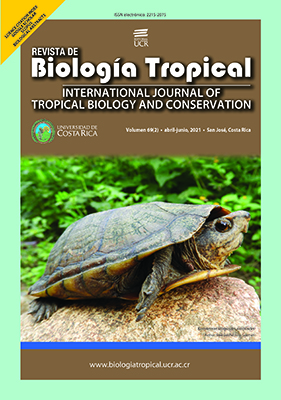Abstract
Introduction. The species and functional diversity of pollinators are important components for the reproduction of cultivated plants. More information is necessary about this diversity and its geographical variation in crops such as Cucurbita pepo, one of the most important crops in global agriculture. Objective. To describe the diversity and geographic variation of the community of bees that visit C. pepo crops in Costa Rica and their foraging s
Introduction: The species and functional diversity of pollinators are important components for the reproduction of cultivated plants. More information is necessary about this diversity and its geographical variation in crops such as Cucurbita pepo, an important crop in global agriculture. Objective: To describe the taxonomic diversity, geographic variation and foraging patterns of the community of bees that visit C. pepo crops in Costa Rica. Methods: Squash fields were visited at 11 locations within three geographic regions of the country, where the groups of bees and their relative frequency were determined. Through video recordings, information was obtained on their behavior at two locations. Results: A minimum of 27 species belonging to 19 genera and 2 families of bees were found. Three species were dominant in 10 localities (Eucera limitaris, Apis mellifera and Trigona corvina). Altitude reduces bee diversity due to the dominance of Bombus ephipiatus in high regions. Two genera of halictids (Megalopta and Caenaugochlora) that are rarely reported in this crop were frequently observed. Trigona bees dominated among the flowers later in the morning, lacerating nectary holes to facilitate nectar collection. Conclusions: Squash fields in Costa Rica are visited by a highly diverse bee community, which may ensure pollination via complementarity in the face of spatial or seasonal changes in environmental conditions.
chedule and intrafloral behavior. Methods. Squash fields were visited at 12 locations within three geographic regions of the country, where the groups of bees and their relative frequency were determined. Through video recordings, information was obtained on their behavior at two locations. Results. A minimum of 27 species belonging to 19 genera and 2 families of bees were found. Three species were dominant at many localities (Eucera limitaris, Apis mellifera and Trigona corvina). Altitude causes drastic changes in their diversity and composition. Two genera of halictids (Megalopta and Caenaugochlora) that are rarely reported in this crop were frequently observed. Trigona bees dominated among the flowers later in the morning. Conclusions. Squash fields in Costa Rica are visited by a highly diverse bee community, which may ensure pollination via complementarity in the face of spatial or seasonal changes in environmental conditions.
##plugins.facebook.comentarios##

This work is licensed under a Creative Commons Attribution 4.0 International License.
Copyright (c) 2021 Jorge A. Lobo, Yanil Bravo Méndez



